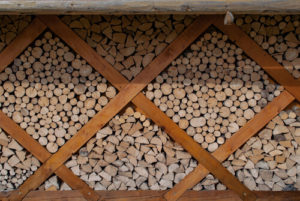It takes a lot of hard work to use wood for home heating fuel. Whether you’re cutting, hauling, and splitting the wood yourself, or buying from a local supplier, you are using your time, money, or both, to prepare for winter each year. The last thing you want is for your wood to take longer to season, due to exposure to snow and rain, or for your seasoned wood to become too wet to light a fire and to burn properly when you need a fire!
Wet Wood
There are two types of wet wood—wood that has been rained or snowed on, and the surface hasn’t dried enough to burn properly, and freshly cut wood that hasn’t dried enough (from the inside) to burn properly. Moisture in and on your wood can keep a fire from burning as hot as desired, can cause fuel to burn incompletely, can increase the amount of creosote produced by the fire, and can be a pain in general. It’s best to cut wood, allow it to season, and to keep it dry so that it’s ready when you need it.
Seasoning Your Firewood
You should leave your wood exposed to air and sunlight while allowing it to properly season, but once it’s dry, it should be covered. You should not pack unseasoned firewood into a tight space or shed to dry. Not only will the airflow not be adequate for drying, but the sunlight will not be able to reach the wood either. If you are concerned about precipitation while your wood is drying, you can use a gravel bed for your stack of wood, to keep it out of standing water, and stack it bark side up to allow the water to runoff instead of penetrating the fleshy wood. Once the wood is ready to burn, you can move it into a woodshed or shelter without worrying about air circulation.
Types of Wood Coverings
Many homeowners still prefer the traditional woodshed, but this isn’t a requirement. If you have a tarp or other plastic covering, you can adequately cover your wood pile so that it’s dry when you need it. You can also stack your wood on your porch. Still, others store up to a week’s supply inside the house (though this isn’t recommended due to the possibility of bugs and rodents that a large pile of wood may bring to your living space). There are many ways to build a shelter that is just the right size for a woodpile. A lean-to is a great option for homeowners who have limited space or who may want to avoid the code stipulations of their city for building a structure. A lean-to generally protects the woodpile on three sides, while leaving an open side to allow easy access when necessary. Find more interesting options for storing wood online and even ask your wood supplier.
If you think your wood is the cause of your chimney woes, call New Buck Chimney Services and ask the professionals. Schedule an appointment with the fireplace experts today.
